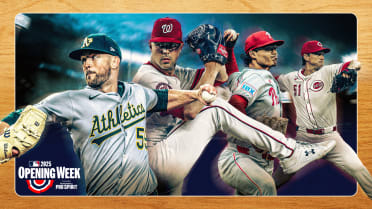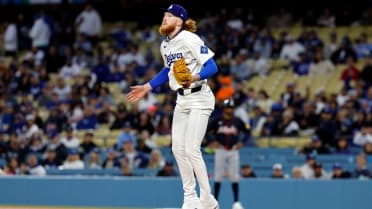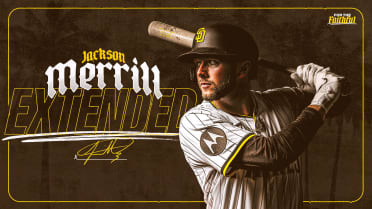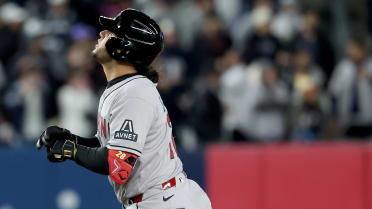The most interesting reliever available in this offseason free-agent market has relatively uninspiring career stats, at least in a traditional sense. He's never had more than seven saves in a season. His career record is 17-20; his ERA is 3.68. He's never made an All-Star team, and he won't generate the same headlines as more celebrated arms like Andrew Miller and Zach Britton might.
Absolutely none of that matters, of course. In a market full of far bigger names and much flashier stats, the reliever who is going to get the contract that shocks you is going to be Adam Ottavino, for the past seven seasons a member of the Colorado Rockies. It's not entirely about what he's done; it's about what teams think he might be able to do. That is, no team cares about Ottavino's 4.56 ERA in 2012 at this point. What can he offer in '19, '20 and '21?
We'll get there. But let's start by pointing out just how strong Ottavino was this past season, when he very legitimately was one of the best relievers in the game.
In 2018, there were 91 relievers who faced 250 batters, or about three per team. We can attempt to look at their performance independent of defense or ballpark -- important, considering where Ottavino called home -- by looking at a Statcast™quality-of-contact metric that accounts for strikeouts, walks and the exit velocity and launch angle allowed at the point of contact. It's called "Expected wOBA," and the Major League average for relievers is .304.
By that measure, the best relievers this year were:
.211 -- Edwin Diaz, Mariners
.227 -- Blake Treinen, A's
.229 -- Adam Ottavino, Rockies
.230 -- Josh Hader, Brewers
.236 -- Dellin Betances, Yankees
.241 -- Thomas Pressly, Twins/Astros
.244 -- Taylor Rogers, Twins
.247 -- Wade Davis, Rockies
... and whether or not you're familiar with that particular metric, the names make sense. Diaz, Treinen and Hader just had three historically strong seasons by just about any measure. Betances bounced back from an up-and-down 2017 to strike out 115 in 66 2/3 innings for the Yankees, and we've been talking up Pressly as a breakout star for months. (What of the relatively unknown Rogers, you say? Perhaps we should be talking about him; he struck out 75 in 68 1/3 innings and allowed just three home runs.)
The point is that it's a list you want to be near the top of, and it might be about now that you're noticing that we're saying that Ottavino was essentially as good as Hader, so let's talk about that.
Hader struck out more batters (46.7 percent) than Ottavino did (36.3 percent). He also walked fewer (9.8 percent) than Ottavino did (11.7 percent). Advantage: Hader.
But when contact was made, Ottavino was harder to square up. His 29.9 percent hard-hit rate was better than Hader's 31.8 percent; his 43 percent ground-ball rate was much higher than Hader's 28.9 percent.
Ottavino isn't as dominating as Hader, not in a pure strikeout sense. But there's value in preventing damage on batted balls, too, and thanks to inducing softer contact and keeping the ball on the ground more, Ottavino closed the gap. Hader may have been the National League's standout reliever in 2018; Ottavino wasn't far behind.
Those numbers are not park-adjusted, remember, which means that so far, Ottavino hasn't been given any credit for the difficulties of his home park. (Not that he had many; he was actually much better at home this year, .124/.223/.195, than he was on the road, .184/.305/.272.)
If we go ahead and do that with a park-adjusted stat like OPS+, where 100 is "league average," we'll get some very similar names. Among all relievers who threw 50 innings this year:
14 OPS+ -- Jose Leclerc, Rangers
17 OPS+ -- Blake Treinen, A's
33 OPS+ -- Josh Hader, Brewers
33 OPS+ -- Edwin Diaz, Mariners
34 OPS+ -- Adam Ottavino, Rockies
37 OPS+ -- Albertin Chapman, Yankees
40 OPS+ -- Seranthony Dominguez, Phillies
Ottavino is again in the top five, right by Treinen, Hader and Diaz. (LeClerc may be the best reliever you don't know, as he put up a 1.56 ERA and struck out 85 in 57 2/3 innings for Texas.)
So it's not at all hard to make the case that Ottavino was one of the five best regular relievers in the game in 2018, and therefore it's not that hard to look at the list of available free-agent relievers and show that he's going to be one of the most sought-after arms there. Let's take a somewhat-arbitrary list of the 10 biggest names who should be available this offseason, and compare Ottavino with each of them based on their 2018 stats. He fares very well.
Ottavino doesn't have the name value of many of those other guys, obviously, in part because he's never been a regular closer. Then again, name value isn't what sells in the market, either, especially when you realize that some of these pitchers are coming off extremely difficult seasons.
Greg Holland, for example, is best known as a Kansas City postseason hero. But he missed all of 2016 due to injury, had a great first half of '17 as Ottavino's teammate with Colorado, then struggled down the stretch, had a 7.92 ERA with St. Louis last season and was designated for assignment in July. (He surfaced with Washington and was somewhat better.) Holland's former teammate on those clubs, Kelvin Herrera, saw his strikeout rate drop from 30.4 percent in '16 to 20.8 percent this year, thanks in part to a right shoulder problem, even before season-ending foot surgery.
Miller missed time this year with injuries to his left hamstring, right knee and throwing shoulder, while posting his lowest strikeout rate since becoming a reliever in 2012. His running mate in Cleveland, Cody Allen, just put up a 4.70 ERA amidst a big home run problem.
Britton missed much of 2017 with a forearm strain, then didn't start his '18 until June after an offseason Achilles tear. While he was his usual groundballing self with the Yankees, he also struck out only 19.8 percent of hitters, a far cry from his elite 31.2 percent mark in '15. Jeurys Familia, meanwhile, has missed time with arm injuries in each of the past two years, though his performance for the Mets and A's was still solid.
That's not to say that none of these guys had good years -- Justin Wilson and Player Page for David Robertson each did -- or that Ottavino is immune from health issues himself. (He had Tommy John surgery in 2015 and missed a few weeks with an oblique strain suffered in May.)
It's not that Ottavino was always this good, either, which is why his career stats don't mean all that much. Last offseason, he famously set up shop in a vacant storefront in Manhattan and set to work with high-tech cameras in an attempt to improve his pitches.
"Sometimes what your brain is telling you is happening is not really happening," Ottavino told FanGraphs earlier this year. "[The high-speed] cameras cut the timeline down immensely. [Without the cameras,] it's trial and error that could have taken years. But with the cameras, it was like four days and I was on the right track."
In 2016, Ottavino threw first-pitch strikes just 47 percent of the time; in '18, that number increased to 60 percent. When he threw pitches in the zone, his contact rate dropped from 88 percent to 80 percent, but at the same time, he got hitters to chase at more pitches outside the zone, increasing from 22 percent to 26 percent.
It was the better control, combined with the video game-like movement on Ottavino's slider, that made him such a different pitcher in 2018. He might not have the name value of Miller, Britton or Holland, or the save totals of Familia or Allen. He's not Craig Kimbrel, because few relievers ever have been. But most of that doesn't matter, not really. Ottavino is going to be a very in-demand reliever this offseason. When he gets a larger contract than longtime stars like Adam Jones or Andrew McCutchen, don't be surprised. Be impressed.
Mike Petriello is an analyst for MLB.com and the host of the Statcast podcast.



